Does Heat Cause Hair Loss? Causes, Signs, & Prevention Tips
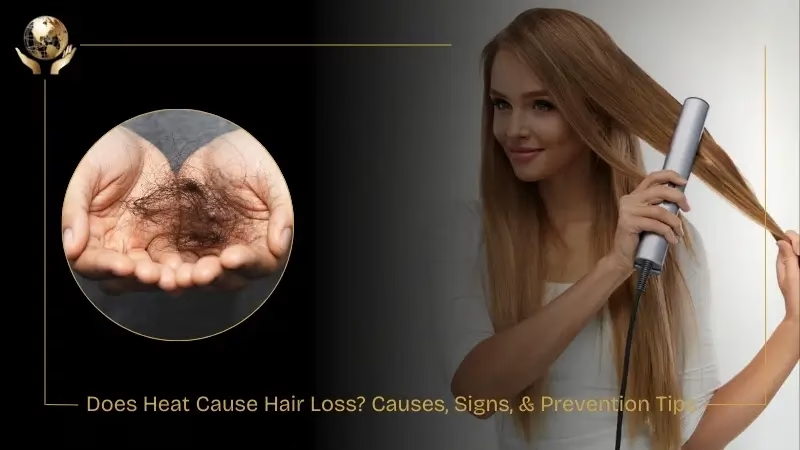
Excessive heat is one of the worst enemies of healthy hair. Daily use of hair styling tools and prolonged exposure to hot weather can take away your hair’s strength and vitality. Over time, strands become weak, the scalp gets dry, and you may notice increased shedding or breakage.
So, does heat cause hair loss? The answer lies in understanding how heat affects both the hair shaft and the scalp. Whether from blow dryers, flat irons, UV rays, or even internal body heat, heat can deteriorate the hair’s natural growth cycle.
This article explores the signs of damaged hair, alternatives to repair or prevent heat-induced hair loss, and heat styling tips. Let’s dive into it.
How Does Heat Damage Hair?
Heat styling tools that exceed temperatures of 200°C, can boil water or denature proteins. intense heat causes microscopic structural changes, including:
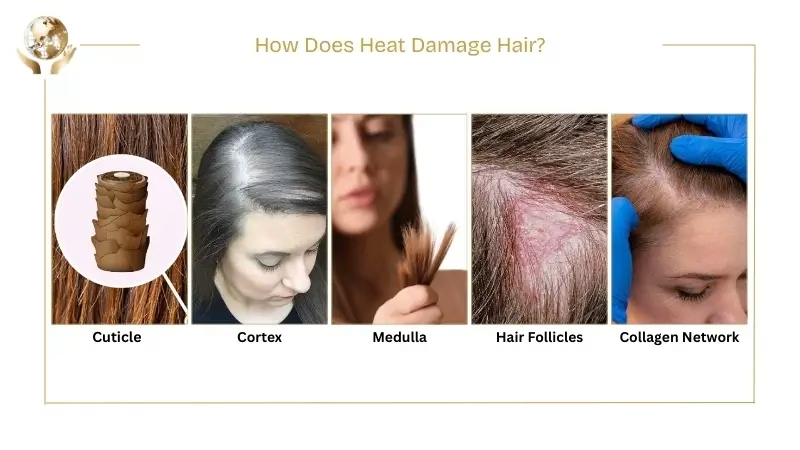
- Cuticle: High temperature cracks the cuticle, the outermost layer of the hair. The hair feels rough and dull. It gradually penetrates to inner layers and causes damage.
- Cortex: It is responsible for strength and elasticity. As the hair breaks down proteins and destroys the moisture balance, it makes it less elastic and prone to breakage.
- Medulla: It is the innermost core. The heat causes collapse internally and makes the hair shaft hollow. As a result, the hair appears thin, lacks volume, and breaks easily.
- Hair Follicles: Due to repeated scalp exposure, the hair follicles get inflamed. The hair starts thinning at the roots or stops growing altogether.
- Collagen Network: Continuous heat exposure can destroy collagen and extracellular matrix proteins. In consequence, the skin structure around the scalp becomes loose and delay in the hair growth cycle is observed.
9 Signs Of Heat Damaged Hair
Using styling tools like blow dryers, flat irons, and curling irons can increase the chances of heat damage. Especially when these tools lack proper temperature control.
High heat can make your hair dry, weak, and more likely to break. While some styling tools can heat up to 450°F and if used without protection can do more harm. Here are the signs of heat damaged hair:
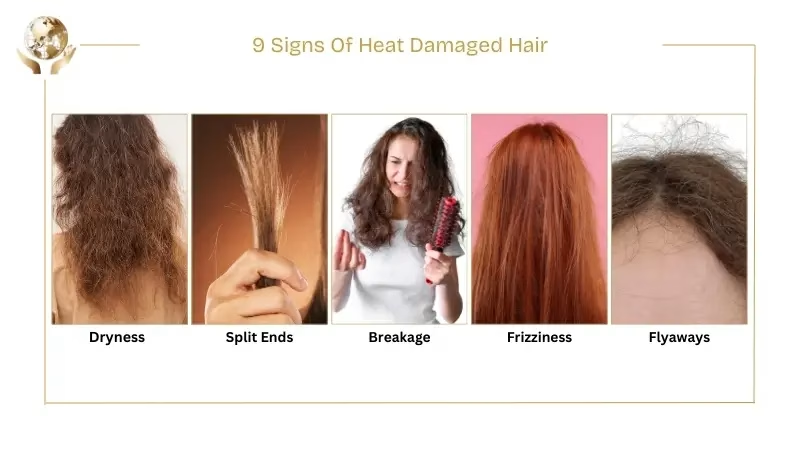
Dryness & Dullness
The hair’s shine is usually from the cuticles. When the cuticles get damaged, the hair loses its healthy glow. After the wash, the hair looks shinier or softer. Dryness doesn’t allow moisture to get intact into the hair. This is why it becomes brittle, rough, and more likely to break.
Split Ends
If heat is applied on a regular basis, the hair loses elasticity and moisture. As the hair becomes dry, it turns stiffer, more prone to snapping and results in split ends.
Split ends, also known as trichoptilosis or schizotrichia occurs when the tips of your hair physically split apart. The tips can show up higher along the strand. Types of splits include:
- Basic Split – Where the hair divides into two.
- Multiple Split – When the hair branches out like a tree.
- Cuticle Split – A part of the cuticle is lost but the cortex remains.
Breakage
Split ends weaken your hair from the inside out, making it more likely to snap. If the high heat is applied constantly, it will strip your hair from moisture and elasticity. The hair even breaks when it’s wet or dry.
If the hair gets tangled, brushing through knots too roughly can cause breakage. To test the breakage, gently tug on a strand. Healthy hair requires a stretch, if it doesn’t and just snaps, it’s a clear sign your hair is damaged and needs some care.
Frizziness
Frizz is one of the frustrating signs of heat damaged hair. It often leads the hair to breakage and dryness. The cuticle lifts up instead of lying flat after getting damaged. It is usually observed in humid weather that the strands puff out, giving you that frizzy, flyaway look.
Frizzy hair is your hair’s way of asking for help. It needs a break from the heat, a good deep conditioner, or a gentle styling routine.
Flyaways
These are annoying little strands that stick up no matter how much you try to smooth them down. Heat styling is one of the reasons. When you use hot tools, especially at high settings, they strip away the moisture, leaving the cuticle rough and damaged.
Flyaways are tricky to manage. Not only this, if you are going for a polished or sleek look, they can mess with your hairstyle. They are a clear sign that indicates your hair needs moisture, less heat, and little extra care.
Rough Or Changed Texture
It is one of the clearest signs of heat damage, when your hair doesn’t feel the way when you run your fingers through it. It starts to feel rough or straw-like instead of smooth and soft.
People with curly hair feel the loss of spring or bounce. Also, straight hair might lose its silky texture and start to feel brittle or coarse. When your hair no longer feels like it used to, then ease up your hair tools and adequate hydration.
Knots & Tangles
Due to roughness, hair strands are tied into knots and tangle more easily. These tangles can be complex to deal with and are usually seen after a shower or throughout the day.
If they are brushed roughly, they often lead to even more breakage. It’s another sign that your hair is stressed and requires active care.
Incorrect Hair Color
When your hair is damaged, it becomes porous. As the cuticle is raised and open, the color seeps into the hair strands quickly. The hair absorbs more dye due to high porosity, making it look darker and patchy.
However, the color fades faster in damaged hair especially after a few washes. Your hair needs some serious attention if the color doesn’t turn out fine or never lasts.
Hair Loss
It’s normal to shed some hair every day. The average person has 80,000 to 120,000 strands on their head. Each strand undergoes a natural growth cycle which lasts for about 2 to 6 years.
Constant heat exposure weakens the strands by breaking down proteins, fats, and moisture. As a result, more hair comes out when you wash and brush them. It’s not just shedding, but also an indication that your hair needs some serious recovery.
See Also: Different Types of Alopecia
How To Protect Your Hair From Heat Damage?
Heat styling doesn’t have to break your hair. You can turn your hair into your favorite looks and keep your strands healthy by following these steps:
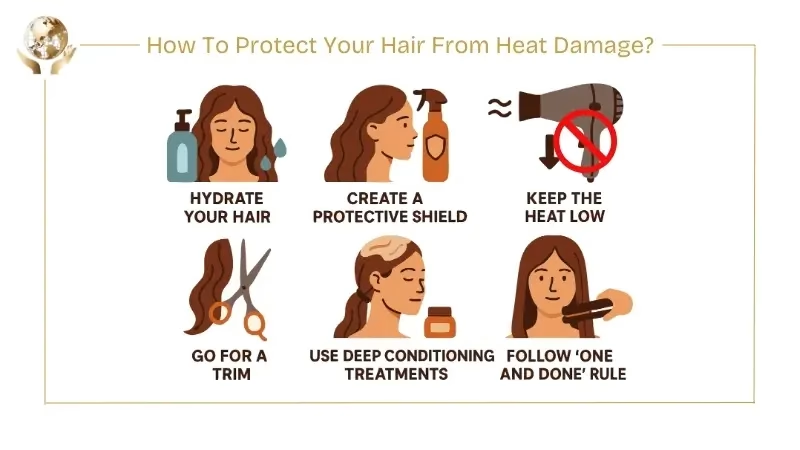
Hydrate Your Hair
Due to excessive heat styling, the hair becomes dehydrated. Whether the heat is from the sun’s UV rays, the water you use to wash your hair, or flat iron, it can dry out your hair strands. As a result, it looks dull and brittle.
Make sure you refresh your hair with moisture to reduce drying out effects. For that, you can use a hydrating shampoo and conditioner during the shower.
Create A Protective Shield
You should never use heat tools without first applying a heat protectant. A high-quality heat protectant forms a barrier around your hair cuticles, thus reducing moisture loss. This protects your hair strands from heat-related stress.
There are also hair serums that protect your hair from temperatures up to 400°F. If extra thermal protection, anti-frizz benefits, and increased shine give your hair exactly what you need, then a protective serum is the right choice.
Keep The Heat Low
Always, try to keep the blow-dryers on the lowest heat setting and adjust the speed for faster drying. While for flat irons or curling wands, a medium setting is enough. Also, try to avoid holding the flat iron in one spot for too long.
When using the curling irons, the contact is limited to 5-10 seconds to avoid overheating the strand. On your off days, if you are not heat-styling or washing, apply a lightweight anti-frizz serum.
Go For A Trim
To repair the heat-damaged hair, make sure to trim the damaged ends. This will protect your hair from further damage or advancing higher up your strands. Your hair will also look thicker and more voluminous.
To obtain best results, go on a regular visit to a salon for your hair care routine.
Use Deep Conditioning Treatments
You can use hair masks and leave-in conditioners to make your hair look smoother. There are coconut and argan oils available that effectively moisturize the hair. This will protect from further damage.
Try to find a heat-damaged hair treatment or hair mask that incorporates these two oils.
Follow ‘One And Done’ Rule
The one and done rule guides the flat iron or curling wand over the same hair piece just once and then moves on. But this can weaken the hair shaft and lead to more damage. The prime purpose is to find the lowest heat setting to style your hair efficiently.
With the right preparation, protectant, and technique, you’ll achieve the look you want without compromising on hair health.
See Also: How to Increase Blood Flow to the Scalp
Can Heat-Damaged Hair Cause Hair Loss?
Yes, excessive heat can cause hair loss by affecting various parts of the hair structure. This outcome is in the form of breakage, shedding, and in some cases even temporary hair loss.
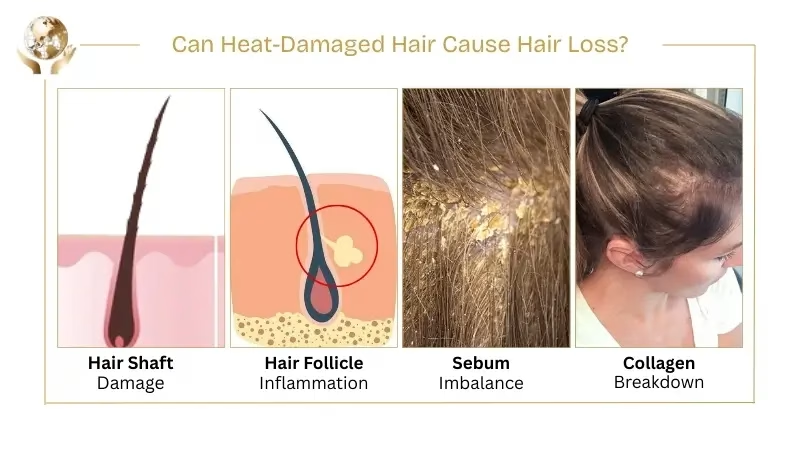
Some of the affected parts of hair structure are as follows:
- Hair Shaft Damage
Due to the high temperature, the cuticle of the hair is exposed which begins to crack and peel. Eventually, the hair turns fragile, brittle, and even breaks off mid-length. Here are some heat-damaged hair symptoms often seen due to this issue:
- Split ends
- Frizz and rough texture
- Uneven length or stunted growth
- Breakage during brushing or styling
- Hair Follicle Inflammation
If high heat is exposed to the scalp directly, it can inflame or irritate the hair follicles. This also disrupts the natural hair growth cycle, leading to visible thinning and delayed regrowth. Common causes include:
- Scalp sunburn
- Hot tools direct on the scalp
- Hot water showers
- Sweating combined with poor scalp hygiene
- Sebum Imbalance
Heat affects the scalp’s sebaceous glands, which produce sebum. As the sebum production gets excessive, it starts clogging the hair follicles, leading to inflammation. Here are some risks associated with this imbalance:
- Scalp acne or bumps
- Hair thinning around the crown
- Oily roots with dry ends
- Collagen Breakdown
Long term infrared or Ultraviolet exposure can breakdown collagen and proteins that support skin and follicle health. As the collagen gets damaged, the hair follicles attain a less structural support. This will weaken the scalp and increase the risk of shedding. Signs of collagen breakdown include:
- Less volume at the roots
- Slower hair regrowth after shedding
- Wrinkles or loss of elasticity on scalp
- Thinning hair or visible scalp
See Also: My Hair Is So Thin I Can See My Scalp
What Temperature Should I Style My Hair On?
The best temperature to style your hair ranges from 120° to 230°. There are different temperature controls required for heat styling products:
| Temperature Range (Celcius) | Hair Type | Instructions |
| 120°C to 150°C | Finer, color-damaged, chemically-treated | Begin with the lowest setting and gradually increase. |
| 150°C to 180°C | Thick, curly, coarse, or resistant | Use a higher temperature for longer-lasting results. Increase heat bit by bit. |
| 230°C | Healthy hair (to withstand highest heat) | This is the highest setting. Start on low and gradually increase. |
Consult with the hairstylist or the member of your team if you are not certain about it.
Heat Styling Tips For Prevention Of Hair Loss
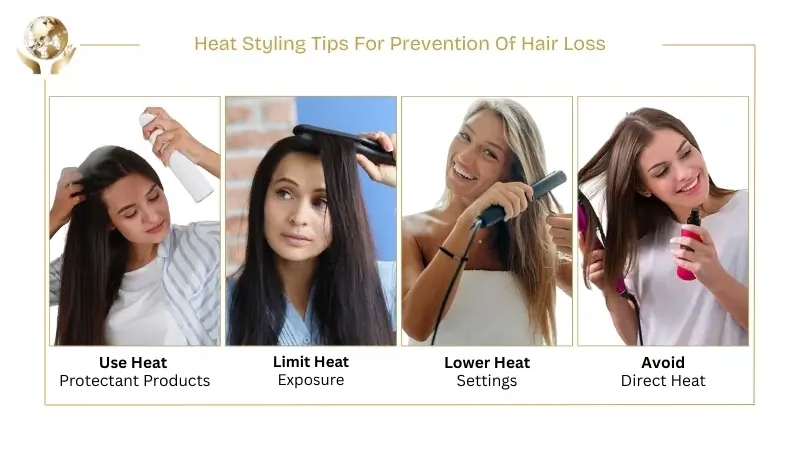
There are many heat styling tips that help prevent hair loss. Some of them are as follows:
- Use Heat Protectant Products: Before starting with heat styling tools, use heat protectant products. These products are effective enough to protect the hair from excessive heat damage.
- Limit Heat Exposure: Use heat styling tools that provide limited heat to reduce the risk of damage. Explore alternative hairstyles that don’t require heat.
- Lower Heat Settings: Use lower heat settings on styling tools to minimize potential damage, especially for fine or delicate hair. Avoid the highest heat settings; keep temperatures between 190°F and 200°F at most.
- Avoid Direct Heat: Don’t directly apply heat on the same hair section for a long time. Distribute heat evenly on all sections. This will diminish damage.
Heat Damage Across Hair Types: Who’s Most at Risk?
Heat doesn’t affect all the hair types in the same manner. It depends entirely upon the structure, porosity, and curl pattern of hair. Here is a comparison table:
| Hair Type | Heat Vulnerability | How Damage Shows Up | Special Care Tips |
| Fine Straight Hair | Very High | Breaks easily, gets limp, loses volume fast | Use low heat, always apply heat protectant |
| Thick Straight Hair | Moderate | Split ends, surface dullness | Use ceramic tools, deep condition weekly |
| Wavy Hair (Type 2) | Moderate to High | Frizz, loose wave pattern, dryness | Diffuse on low heat, scrunch with leave-in conditioner |
| Curly Hair (Type 3) | High | Curl pattern loosens or gets distorted, dryness | Limit heat tools, air-dry when possible |
| Coily/Kinky Hair (Type 4) | Very High | Extreme dryness, shrinkage, strand snapping | Avoid direct heat, use heat only on stretched hair |
| Color-Treated Hair | Extremely High | Fades color, increases porosity, causes brittleness | Use color-safe heat protectants, reduce styling frequency |
See Also: Finasteride for Hair Loss in Female
How To Support Healthy Hair?
Healthy hair requires consistent care, both inside and out. Here are some ways that provide support to healthy hair:
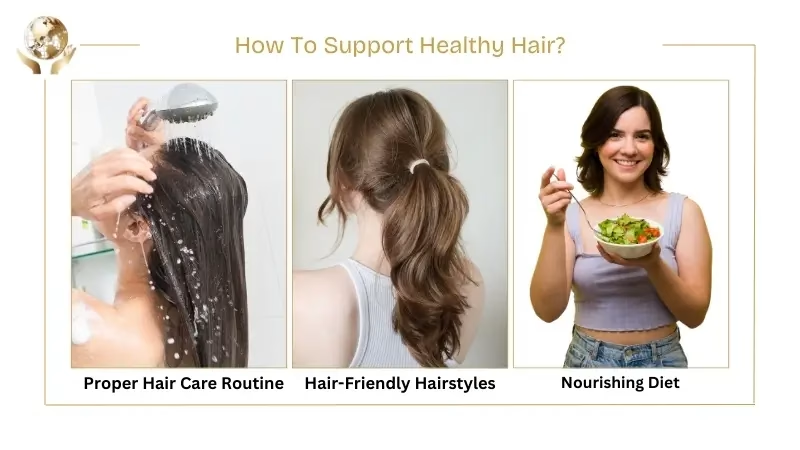
- Proper Hair Care Routine – It includes a healthy haircare routine such as washing and conditioning. Use quality hair products that contribute to overall health and make the hair strong.
- Hair-Friendly Hairstyles – Choose hairstyles, such as:
- Loose braids
- Low ponytails
- Half-up half-down styles
- Heatless curls
- Half-top knot
- Space buns
- Pulled-out dutch braid
- Messy buns
- Braided buns
- Nourishing Diet – A balanced diet must be rich in nutrients, vitamins, and minerals that include:
- Biotin (B7)
- Iron
- Zinc
- Vitamin E
- Vitamin D
- Omega-3 fatty acids
- Niacin (B3)
All these essential ingredients help in promoting healthy and stronger hair growth.

This article is medically reviewed by Head Physician & Aesthetic Dr. Bulent
See Our Doctors & Surgeons
Do you lose more hair in hot weather?
Yes, hot weather causes hair loss. It contributes to increased hair shedding and is due to dehydration, sun exposure, and excessive sweating.
What does heat damaged hair look like?
Heat-damaged hair often looks dry, frizzy, and dull.
Does burnt hair grow back thicker?
No, burnt hair doesn’t grow back thicker. If the hair is burned, it must be trimmed at the ends.
At what temperature is hair damaged?
The hair’s protein structure begins to sustain damage at temperatures above 150°C (300°F), and more noticeable damage occurs above 230°C (450°F).
What is the best oil for heat damaged hair?
The best oils include argan oil, coconut oil, jojoba oil, and grapeseed oil.
How often can I use heat on my hair without damaging it?
The hair styling must not be done more than 1-2 times per week.
Which weather is the worst for hair?
Hot, humid weather leads to frizzy hair. While cold weather strips away the moisture from the hair, making it brittle.
What does sun damaged hair look like?
Sun-damaged hair looks faded, dry, or straw-like.
Why is my hair so dry if I don’t use heat?
It is due to overwashing, harsh products, dehydration, or environmental factors such as cold air or sun exposure.






